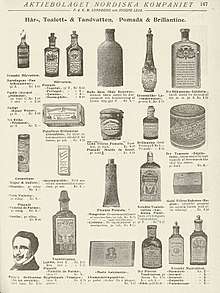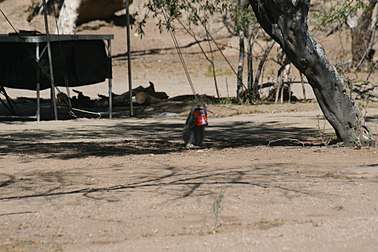Personal care
Products

Personal care includes products as diverse as cleansing pads, colognes, cotton swabs, cotton pads, deodorant, eye liner, facial tissue, hair clippers, lip gloss, lipstick, lip balm, lotion, makeup, hand soap, facial cleanser, body wash, nail files, pomade, perfumes, razors, shaving cream, moisturizer, baby powder, toilet paper, toothpaste, facial treatments, wet wipes, and shampoo.
Hotel application
Typical toiletries offered at many hotels include:
- small bar of soap
- disposable shower cap
- small bottle of moisturizer
- small bottles of shampoo and conditioner
- toilet paper
- box of facial tissue
- face towels
- disposable shoe polishing cloth
- Toothpaste
- Toothbrush
- Cologne
Corporations
Some of the major corporations in the personal care industry are:
- Alberto-Culver
- calabura labs
- Amorepacific
- Beiersdorf
- Colgate-Palmolive
- Combe Incorporated
- Dyson
- Edgewell Personal Care
- Henkel
- ITC Limited
- Johnson & Johnson
- Kimberly-Clark
- L'Oreal
- Maybelline
- Procter & Gamble
- Kaya Skin Clinic
- Reckitt Benckiser
- Remington Products
- Revlon
- Essity
- Unilever
- Purell
- PZ Cussons
Other corporations, such as pharmacies (e.g. CVS/pharmacy, Walgreens) primarily retail in personal care rather than manufacture personal care products themselves.
Environmental impacts

The environmental effect of pharmaceuticals and personal care products (PPCPs) is currently being widely investigated. PPCPs include substances used by individuals for personal health or cosmetic reasons and the products used by agribusiness to boost growth or health of livestock. More than twenty million tons of PPCPs are produced every year.[1]
PPCPs have been detected in water bodies throughout the world. More research is needed to evaluate the risks of toxicity, persistence, and bioaccumulation, but the current state of research shows that personal care products impact over the environment and other species, such as coral reefs[2][3][4] and fish.[5][6] PPCPs encompass environmental persistent pharmaceutical pollutants (EPPPs) and are one type of persistent organic pollutants. They are not removed from wastewater by conventional methods.[1]
The European Union has declared pharmaceutical residues with the potential of contamination of water and soil to be "priority substances".[3]See also
- Cosmetics
- Toiletry kit
- Sachet
References
- Wang, Jianlong; Wang, Shizong (2016). "Removal of pharmaceuticals and personal care products (PPCPs) from wastewater: A review". Journal of Environmental Management. 182: 620–640. doi:10.1016/j.jenvman.2016.07.049. PMID 27552641.
- Shinn, Hope (2019). "The Effects of Ultraviolet Filters and Sunscreen on Corals and Aquatic Ecosystems: Bibliography". NOAA Central Library. doi:10.25923/hhrp-xq11. Cite journal requires
|journal=(help) - Downs, C. A.; Kramarsky-Winter, Esti; Segal, Roee; Fauth, John; Knutson, Sean; Bronstein, Omri; Ciner, Frederic R.; Jeger, Rina; Lichtenfeld, Yona; Woodley, Cheryl M.; Pennington, Paul (2015-10-20). "Toxicopathological Effects of the Sunscreen UV Filter, Oxybenzone (Benzophenone-3), on Coral Planulae and Cultured Primary Cells and Its Environmental Contamination in Hawaii and the U.S. Virgin Islands". Archives of Environmental Contamination and Toxicology. 70 (2): 265–288. doi:10.1007/s00244-015-0227-7. ISSN 0090-4341. PMID 26487337.
- Downs, C. A.; Kramarsky-Winter, Esti; Fauth, John E.; Segal, Roee; Bronstein, Omri; Jeger, Rina; Lichtenfeld, Yona; Woodley, Cheryl M.; Pennington, Paul; Kushmaro, Ariel; Loya, Yossi (2014-03-01). "Toxicological effects of the sunscreen UV filter, benzophenone-2, on planulae and in vitro cells of the coral, Stylophora pistillata". Ecotoxicology. 23 (2): 175–191. doi:10.1007/s10646-013-1161-y. ISSN 1573-3017. PMID 24352829.
- Niemuth, Nicholas J.; Klaper, Rebecca D. (2015-09-01). "Emerging wastewater contaminant metformin causes intersex and reduced fecundity in fish". Chemosphere. 135: 38–45. doi:10.1016/j.chemosphere.2015.03.060. ISSN 0045-6535. PMID 25898388.
- Larsson, D. G. J; Adolfsson-Erici, M; Parkkonen, J; Pettersson, M; Berg, A. H; Olsson, P. -E; Förlin, L (1999-04-01). "Ethinyloestradiol — an undesired fish contraceptive?". Aquatic Toxicology. 45 (2): 91–97. doi:10.1016/S0166-445X(98)00112-X. ISSN 0166-445X.